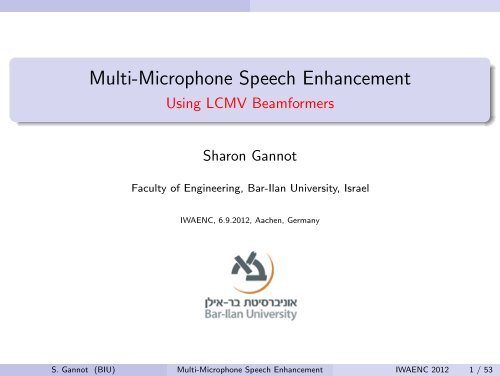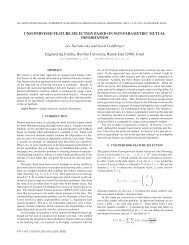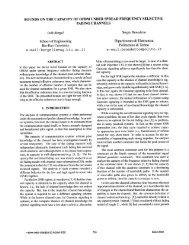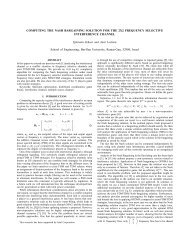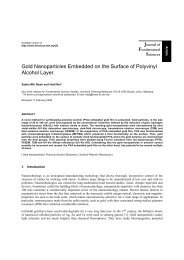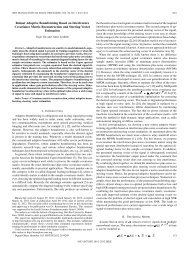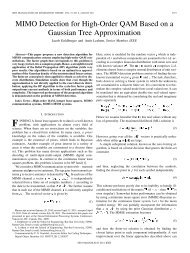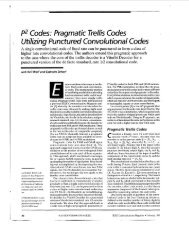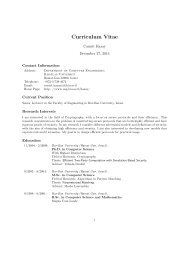Multi-Microphone Speech Enhancement - =1=Using LCMV ...
Multi-Microphone Speech Enhancement - =1=Using LCMV ...
Multi-Microphone Speech Enhancement - =1=Using LCMV ...
Create successful ePaper yourself
Turn your PDF publications into a flip-book with our unique Google optimized e-Paper software.
<strong>Multi</strong>-<strong>Microphone</strong> <strong>Speech</strong> <strong>Enhancement</strong><br />
Using <strong>LCMV</strong> Beamformers<br />
Sharon Gannot<br />
Faculty of Engineering, Bar-Ilan University, Israel<br />
IWAENC, 6.9.2012, Aachen, Germany<br />
S. Gannot (BIU) <strong>Multi</strong>-<strong>Microphone</strong> <strong>Speech</strong> <strong>Enhancement</strong> IWAENC 2012 1 / 53
Introduction<br />
<strong>Speech</strong> <strong>Enhancement</strong> and Source Extraction<br />
Utilizing <strong>Microphone</strong> Arrays<br />
Applications<br />
1 Hands-free communications.<br />
2 Teleconference.<br />
3 Skype calls.<br />
4 Hearing aids.<br />
5 Eavesdropping.<br />
Why is it a Difficult Task?<br />
1 <strong>Speech</strong> is a non-stationary<br />
signal that has high dynamic<br />
range.<br />
2 Very long acoustic path<br />
(reverberation).<br />
3 Time varying acoustic path.<br />
4 <strong>Microphone</strong> arrays impose<br />
high computational burden.<br />
5 Large (and distributed)<br />
arrays require large<br />
communication bandwidth.<br />
S. Gannot (BIU) <strong>Multi</strong>-<strong>Microphone</strong> <strong>Speech</strong> <strong>Enhancement</strong> IWAENC 2012 2 / 53
Introduction<br />
Room Acoustics Essentials<br />
Reverberation<br />
Late reflections tend to be<br />
diffused, hence performance<br />
degradation.<br />
Beamforming: higher<br />
processing burden and high<br />
latency in STFT<br />
implementation.<br />
Deteriorates intelligibility,<br />
quality and ASR<br />
performance.<br />
Sound Fields<br />
Directional Room impulse<br />
response relates source and<br />
microphones.<br />
Uncorrelated Signals on<br />
microphone are uncorrelated.<br />
Diffused Sound is coming<br />
from all directions.<br />
Dal-Degan, Prati, 1988; Habets, Gannot, 2007<br />
S. Gannot (BIU) <strong>Multi</strong>-<strong>Microphone</strong> <strong>Speech</strong> <strong>Enhancement</strong> IWAENC 2012 3 / 53
Spatial Processing<br />
Design Criteria<br />
Introduction<br />
Tailored to <strong>Speech</strong> Applications<br />
1 BSS, CASA. Other methods<br />
2 Adaptive optimization Sondhi, Elko, 1986; Kaneda, Ohga, 1986.<br />
3 Minimum variance distortionless response (MVDR) and GSC.<br />
Van Compernolle, 1990; Affes and Grenier, 1997; Nordholm et al., 1999; Hoshuyama et al., 1999 Gannot et al., 2001;<br />
Herbordt et al., 2005<br />
4 Minimum mean square error (MMSE) - GSVD based spatial Wiener<br />
filter. Doclo, Moonen, 2002<br />
5 <strong>Speech</strong> distortion weighted multichannel Wiener filter (SDW-MWF).<br />
Spriet et al., 2004<br />
6 Maximum signal to noise ratio (SNR). Warsitz and Haeb-Umbach, 2005<br />
7 Linearly constrained minimum variance (<strong>LCMV</strong>). Markovich et al., 2009<br />
S. Gannot (BIU) <strong>Multi</strong>-<strong>Microphone</strong> <strong>Speech</strong> <strong>Enhancement</strong> IWAENC 2012 4 / 53
Problem Formulation<br />
Problem Formulation<br />
Extraction of Desired Speaker Signal(s) in <strong>Multi</strong>-Interference Reverberant Environment<br />
Noise source<br />
Desired speech<br />
Interference signal<br />
<strong>Microphone</strong> array<br />
<strong>Microphone</strong> Array<br />
Enhanced speech/ Localization & Tracking<br />
Ambient Noise<br />
S. Gannot (BIU) <strong>Multi</strong>-<strong>Microphone</strong> <strong>Speech</strong> <strong>Enhancement</strong> IWAENC 2012 5 / 53
Problem Formulation<br />
Talk Outline<br />
Spatial processors (“beamformers”) based on the linearly constrained<br />
minimum variance (<strong>LCMV</strong>) criterion.<br />
Special cases:<br />
Enhancing single desired source (MVDR).<br />
Extracting desired source(s) in multiple competing speaker<br />
environment.<br />
Implementation: Generalized sidelobe canceller (GSC) in the<br />
short-time Fourier transform (STFT) domain.<br />
The relative transfer function (RTF): importance and estimation<br />
procedures.<br />
The applicability of the <strong>LCMV</strong> to binaural processing.<br />
S. Gannot (BIU) <strong>Multi</strong>-<strong>Microphone</strong> <strong>Speech</strong> <strong>Enhancement</strong> IWAENC 2012 6 / 53
Problem Formulation<br />
Problem Formulation in the STFT Domain<br />
<strong>Microphone</strong> Signals (m = 1, . . . , M):<br />
N d<br />
∑<br />
z m (l, k) = sj d (l, k)hjm(l, d k)<br />
N i<br />
Vector Formulation<br />
j=1<br />
∑<br />
∑N n<br />
+ sj i (l, k)hjm(l, i k) + sj n (l, k)hjm(k) n + n m (l, k)<br />
j=1<br />
j=1<br />
z(l, k) = H d (l, k)s d (l, k) + H i (k)s i (l, k) + H n (l, k)s n (l, k) + n(l, k)<br />
} {{ }<br />
v(l,k); stationary component<br />
N = N d + N i + N n<br />
≤ M<br />
S. Gannot (BIU) <strong>Multi</strong>-<strong>Microphone</strong> <strong>Speech</strong> <strong>Enhancement</strong> IWAENC 2012 7 / 53
Spatial Filters<br />
Problem Formulation<br />
Filter and Combine<br />
y(l, k) = w H (l, k)z(l, k).<br />
z 1 (l, k)<br />
w ∗ 1(l, k)<br />
z 2 (l, k)<br />
w2 ∗ (l, k)<br />
y(l, k)<br />
z M (l, k)<br />
∑<br />
wM ∗ (l, k)<br />
S. Gannot (BIU) <strong>Multi</strong>-<strong>Microphone</strong> <strong>Speech</strong> <strong>Enhancement</strong> IWAENC 2012 8 / 53
<strong>LCMV</strong> Beamformer<br />
Criterion and Solution<br />
The Linearly Constrained Minimum Variance Beamformer<br />
Er, Cantoni, 1983; Van Veen, Buckley, 1988<br />
y(l, k) = w H (l, k)z(l, k)<br />
<strong>LCMV</strong> Criterion<br />
Let Φ zz (l, k) be the received signals correlation matrix.<br />
Minimize output power<br />
w H (l, k)Φ zz (l, k)w(l, k),<br />
such that the linear constraint set is satisfied:<br />
C H (l, k)w(l, k) = g(l, k).<br />
Closed-form solution exists (but we hardly use them)<br />
S. Gannot (BIU) <strong>Multi</strong>-<strong>Microphone</strong> <strong>Speech</strong> <strong>Enhancement</strong> IWAENC 2012 9 / 53
<strong>LCMV</strong> Minimization<br />
Graphical Interpretation Frost, 1972<br />
<strong>LCMV</strong> Beamformer<br />
Criterion and Solution<br />
w 2<br />
w 1<br />
w † (l, k)Φ zz(l, k)w(l, k)<br />
w(l, k)<br />
w 0(l, k) =C(l, k) ( C † (l, k)C(l, k) ) −1 g(l, k)<br />
Constraint plane: C † (l, k)w(l, k) =g(l, k)<br />
S. Gannot (BIU) <strong>Multi</strong>-<strong>Microphone</strong> <strong>Speech</strong> <strong>Enhancement</strong> IWAENC 2012 10 / 53
<strong>LCMV</strong> Beamformer<br />
The GSC Implementation<br />
The Generalized Sidelobe Canceller Implementation<br />
w 2<br />
Split the Beamformer<br />
w = w 0 − w n<br />
w n B H q<br />
Constraints Subspace<br />
w 0 ∈ Span{C}<br />
Null Subspace<br />
(columns of B span N {C})<br />
w n = −Bq<br />
w new<br />
w old<br />
w 1<br />
w 0<br />
Constraint plane<br />
Constraint subspace<br />
S. Gannot (BIU) <strong>Multi</strong>-<strong>Microphone</strong> <strong>Speech</strong> <strong>Enhancement</strong> IWAENC 2012 11 / 53
<strong>LCMV</strong> Beamformer<br />
The GSC Implementation<br />
The GSC Structure Griffiths, Jim, 1982<br />
z 1(l, k)<br />
z 2(l, k)<br />
FBF<br />
y FBF(l, k)<br />
+<br />
−<br />
y ANC(l, k)<br />
∑<br />
y(l, k)<br />
z M(l),k<br />
u 1(l),k<br />
BM<br />
u 2(l, k)<br />
u M(l, k)<br />
ANC<br />
q(l, k)<br />
S. Gannot (BIU) <strong>Multi</strong>-<strong>Microphone</strong> <strong>Speech</strong> <strong>Enhancement</strong> IWAENC 2012 12 / 53
MVDR<br />
Criterion, Solution, GSC<br />
The Minimum Variance Distortionless Beamformer<br />
Single Constraint<br />
Scenario:<br />
One desired signal.<br />
Beamformer Design:<br />
“Steers beam” towards the desired source (one constraint).<br />
Minimize all other directions.<br />
C = h d<br />
g = 1<br />
S. Gannot (BIU) <strong>Multi</strong>-<strong>Microphone</strong> <strong>Speech</strong> <strong>Enhancement</strong> IWAENC 2012 13 / 53
MVDR<br />
Criterion, Solution, GSC<br />
The MVDR Beamformer<br />
GSC Implementation Affes, Grenier, 1997; Hoshuyama et al., 1999; Gannot et al., 2000<br />
GSC Blocks:<br />
FBF - matched filter to the desired response, h d .<br />
BM - projection matrix to the null space of h d .<br />
ANC - recursively updated using the LMS algorithm (Shynk, 1992).<br />
Output signal:<br />
y = s d + residual noise and interference signals<br />
S. Gannot (BIU) <strong>Multi</strong>-<strong>Microphone</strong> <strong>Speech</strong> <strong>Enhancement</strong> IWAENC 2012 14 / 53
The Transfer Function GSC<br />
Relative Transfer Function<br />
The Transfer Function GSC<br />
Relax Dereverberation Requirement Gannot et al., 2001<br />
Modified Constraint Set:<br />
C = h d<br />
˜g = (h d 1 ) ∗<br />
Equivalent to:<br />
C = ˜h d hd<br />
h d 1<br />
=<br />
[<br />
1 hd 2<br />
h d 1<br />
. . . hd M<br />
h d 1<br />
] T<br />
g = 1.<br />
S. Gannot (BIU) <strong>Multi</strong>-<strong>Microphone</strong> <strong>Speech</strong> <strong>Enhancement</strong> IWAENC 2012 15 / 53
The Transfer Function GSC<br />
Relative Transfer Function<br />
The Transfer Function GSC utilizing RTF<br />
RTF suffices for implementing all blocks of the GSC.<br />
Output signal:<br />
y = h1 d s d +residual noise and interference signals<br />
}{{}<br />
s1<br />
d<br />
Tradeoff:<br />
Noise reduction is sacrificed if dereverberation required Habets et al., 2010.<br />
S. Gannot (BIU) <strong>Multi</strong>-<strong>Microphone</strong> <strong>Speech</strong> <strong>Enhancement</strong> IWAENC 2012 16 / 53
The Transfer Function GSC<br />
RTF Estimation<br />
The Importance of the RTF<br />
Advantages<br />
Shorter than the ATF.<br />
Estimation methods are available:<br />
Using speech non-stationarity (Gannot et al., 2001).<br />
Using speech probability and spectral subtraction Cohen, 2004.<br />
RTF equivalent to Interaural Transfer Function (ITF).<br />
Drawbacks<br />
Non-causal<br />
CTF-GSC<br />
For high T 60 multiplication in the frequency domain is only valid for very<br />
long frames. Hence, the RTFs will be extended to convolution in the<br />
STFT domain (CTF-GSC) Talmon et al., 2009.<br />
S. Gannot (BIU) <strong>Multi</strong>-<strong>Microphone</strong> <strong>Speech</strong> <strong>Enhancement</strong> IWAENC 2012 17 / 53
<strong>Multi</strong>-Constraint GSC<br />
Applications<br />
<strong>Multi</strong> Constraint Beamformer<br />
Based on <strong>Multi</strong>channel Eigenspace Beamforming Markovich et al., 2009; 2010<br />
Applications:<br />
Conference call scenario with multiple participants.<br />
Hands-free cellular phone conversation in a car environment with<br />
several passengers.<br />
Cocktail Party scenario, in which desired conversation blend with<br />
many simultaneous conversations.<br />
Problem Formulation (Reminder):<br />
z = H d s d + H i s i + H n s n + n<br />
S. Gannot (BIU) <strong>Multi</strong>-<strong>Microphone</strong> <strong>Speech</strong> <strong>Enhancement</strong> IWAENC 2012 18 / 53
The Constraints Set<br />
<strong>Multi</strong>-Constraint GSC<br />
Derivation<br />
Original<br />
C H = [ H d H i H n ]<br />
[<br />
1 . . . 1<br />
g } {{ } 0 } .{{ . . 0}<br />
N d<br />
N−N d<br />
] T<br />
<strong>LCMV</strong> output<br />
N d<br />
∑<br />
y =<br />
j=1<br />
s d j<br />
+ noise components<br />
S. Gannot (BIU) <strong>Multi</strong>-<strong>Microphone</strong> <strong>Speech</strong> <strong>Enhancement</strong> IWAENC 2012 19 / 53
<strong>Multi</strong>-Constraint GSC<br />
A Modified Constraints Set<br />
Derivation<br />
Noise & Interfernce<br />
Replace the ATFs by an equivalent orthonormal basis Q.<br />
Relax the dereverberation requirements using RTFs:<br />
[ ]<br />
(h<br />
d<br />
11 ) ∗ . . . (h d T<br />
N<br />
˜g <br />
d 1<br />
} {{ )∗ 0 . . . 0<br />
} } {{ } ⇒ ˜h d N−N<br />
j h d j /hj1<br />
d<br />
N d d<br />
The modified Constraints Set<br />
˜C [ ˜H d Q ]<br />
(estimation by applying subspace methods)<br />
<strong>LCMV</strong> output<br />
∑N d<br />
y =<br />
+ noise components<br />
hj1s d j<br />
d<br />
j=1<br />
S. Gannot (BIU) <strong>Multi</strong>-<strong>Microphone</strong> <strong>Speech</strong> <strong>Enhancement</strong> IWAENC 2012 20 / 53
Single Desired Speaker<br />
Directional Noise Field<br />
<strong>Multi</strong>-Constraint GSC<br />
Experimental Study<br />
(a) Noisy at mic. #1<br />
(b) Enhanced signal<br />
Figure: Female (desired) and male (interference) with Directional noise. 8<br />
microphones recorded at BIU acoustic lab set to T 60 = 300ms.<br />
S. Gannot (BIU) <strong>Multi</strong>-<strong>Microphone</strong> <strong>Speech</strong> <strong>Enhancement</strong> IWAENC 2012 21 / 53
<strong>Multi</strong>-Speaker<br />
<strong>Multi</strong>-Constraint GSC<br />
Experimental Study<br />
(a) Noisy at mic. #1<br />
(b) Enhanced signal<br />
Figure: 1 desired source and 3 competing speakers. 8 microphones recorded at<br />
BIU acoustic lab set to T 60 = 300ms. Approximately 20dB SIR and SNR<br />
improvement.<br />
S. Gannot (BIU) <strong>Multi</strong>-<strong>Microphone</strong> <strong>Speech</strong> <strong>Enhancement</strong> IWAENC 2012 22 / 53
Binaural <strong>LCMV</strong><br />
Binaural <strong>LCMV</strong> Beamformer<br />
Hadad, Gannot, Doclo, 2012<br />
Motivation<br />
Duplicate the <strong>LCMV</strong> beamformer at<br />
both ears utilizing all microphones.<br />
The concept of RTF can be<br />
extended and used for preservation<br />
of binaural cues (ILD & ITD).<br />
Efficient implementation by block<br />
sharing.<br />
S. Gannot (BIU) <strong>Multi</strong>-<strong>Microphone</strong> <strong>Speech</strong> <strong>Enhancement</strong> IWAENC 2012 23 / 53
Problem Formulation<br />
Binaural <strong>LCMV</strong><br />
Problem Formulation<br />
<strong>Microphone</strong> Signals<br />
z = H d s d + H i s i + v<br />
Left & Right Reference <strong>Microphone</strong>s<br />
where<br />
e l =<br />
z l = e H l z;<br />
{ 1 m = ml<br />
0 otherwise<br />
z r = e H r z<br />
e r =<br />
{ 1 m = mr<br />
0 otherwise<br />
Binaural Spatial Filters<br />
y l = w H l z; y r = w H r z.<br />
S. Gannot (BIU) <strong>Multi</strong>-<strong>Microphone</strong> <strong>Speech</strong> <strong>Enhancement</strong> IWAENC 2012 24 / 53
Double <strong>LCMV</strong> Criterion<br />
Binaural <strong>LCMV</strong><br />
Problem Formulation<br />
Two BFs Utilizing All <strong>Microphone</strong>s<br />
w l = <strong>LCMV</strong>(z; C, g l ); w r = <strong>LCMV</strong>(z; C, g r )<br />
Orthonormal Basis for the ATFs<br />
{H d = Q d Θ d ; H i = Q i Θ i } ⇒ C = [ Q d Q i<br />
]<br />
Left & Right Response Vectors<br />
Apply dereverberation relaxation utilizing RTFs.<br />
Cue Gain Factors:<br />
Desired response 0 < η ≈ 1; Interference response 0 < µ ≪ 1<br />
S. Gannot (BIU) <strong>Multi</strong>-<strong>Microphone</strong> <strong>Speech</strong> <strong>Enhancement</strong> IWAENC 2012 25 / 53
Binaural <strong>LCMV</strong><br />
Interaural Signal Ratio (ISR)<br />
ISR vs. ITF<br />
Input ISR<br />
ISR in = z l<br />
z r<br />
= e† l (H ds d + H i s i )<br />
e † r (H d s d + H i s i ) .<br />
Output ISR (in our implementation)<br />
ISR out = y l<br />
y r<br />
= e† l (ηH ds d + µH i s i )<br />
e † r (ηH d s d + µH i s i ) .<br />
S. Gannot (BIU) <strong>Multi</strong>-<strong>Microphone</strong> <strong>Speech</strong> <strong>Enhancement</strong> IWAENC 2012 26 / 53
Binaural <strong>LCMV</strong><br />
ISR vs. ITF<br />
ISR vs. ITF<br />
Properties<br />
Single source case: ISR out = ISR in and ISR identifies with the ITF.<br />
Only one group is active ⇒ spatial cues of the group maintained.<br />
<strong>Speech</strong> sparsity in STFT domain ⇒ cues are preserved also for<br />
arbitrary activity pattern.<br />
Binaural cue preservation is only guaranteed for the constrained<br />
sources.<br />
Unconstrained stationary noise sources and residual (constrained)<br />
interference sources will “inherit” the input cues of the dominant<br />
source.<br />
0 < µ ≪ 1 will mask the artifacts resulting from leakage.<br />
S. Gannot (BIU) <strong>Multi</strong>-<strong>Microphone</strong> <strong>Speech</strong> <strong>Enhancement</strong> IWAENC 2012 27 / 53
Block Diagram<br />
Binaural <strong>LCMV</strong><br />
Implementation<br />
FBF<br />
N d + N i<br />
g l<br />
g r<br />
+ +<br />
-<br />
y r<br />
M<br />
z<br />
+<br />
+<br />
-<br />
y l<br />
BM<br />
q r<br />
q l<br />
M − N d − N i<br />
ANC<br />
S. Gannot (BIU) <strong>Multi</strong>-<strong>Microphone</strong> <strong>Speech</strong> <strong>Enhancement</strong> IWAENC 2012 28 / 53
Binaural <strong>LCMV</strong><br />
Experimental Study<br />
Sonograms<br />
Right Signal and Stereo Waveforms (Left and Right)<br />
Setup<br />
2 hearing aid devices, 2 microphones each, utility device with 4 mics.<br />
Cue gain factors: η = 1, µ = 0.1 (20dB attenuation).<br />
(a) Desired speaker, reference mic. (b) Received reference microphones (c) B<strong>LCMV</strong> outputs<br />
S. Gannot (BIU) <strong>Multi</strong>-<strong>Microphone</strong> <strong>Speech</strong> <strong>Enhancement</strong> IWAENC 2012 29 / 53
Binaural <strong>LCMV</strong><br />
Experimental Study<br />
ILD & ITD Preservation (Faller and Merimaa, 2004)<br />
5<br />
p(∆L)<br />
5<br />
p(∆L)<br />
∆L [dB]<br />
0<br />
∆L [dB]<br />
0<br />
−5<br />
−5<br />
p(τ)<br />
p(τ)<br />
−1 −0.5 0 0.5 1<br />
τ [ms]<br />
−1 −0.5 0 0.5 1<br />
τ [ms]<br />
(a) Noisy input<br />
(b) Enhanced output<br />
5<br />
p(∆L)<br />
5<br />
p(∆L)<br />
∆L [dB]<br />
0<br />
∆L [dB]<br />
0<br />
−5<br />
−5<br />
p(τ)<br />
p(τ)<br />
−1 −0.5 0 0.5 1<br />
τ [ms]<br />
(c) Desired input<br />
−1 −0.5 0 0.5 1<br />
τ [ms]<br />
(d) Desired output<br />
S. Gannot (BIU) <strong>Multi</strong>-<strong>Microphone</strong> <strong>Speech</strong> <strong>Enhancement</strong> IWAENC 2012 30 / 53
Binaural <strong>LCMV</strong> Experimental Study<br />
ILD & ITD Preservation (Faller and Merimaa, 2004) (cont.)<br />
5<br />
p(∆L)<br />
5<br />
p(∆L)<br />
∆L [dB]<br />
0<br />
∆L [dB]<br />
0<br />
−5<br />
−5<br />
p(τ)<br />
p(τ)<br />
−1 −0.5 0 0.5 1<br />
τ [ms]<br />
−1 −0.5 0 0.5 1<br />
τ [ms]<br />
(e) Interference input<br />
(f) Interference output<br />
5<br />
p(∆L)<br />
5<br />
p(∆L)<br />
∆L [dB]<br />
0<br />
∆L [dB]<br />
0<br />
−5<br />
−5<br />
p(τ)<br />
p(τ)<br />
−1 −0.5 0 0.5 1<br />
τ [ms]<br />
(g) Stationary input<br />
−1 −0.5 0 0.5 1<br />
τ [ms]<br />
(h) Stationary output<br />
S. Gannot (BIU) <strong>Multi</strong>-<strong>Microphone</strong> <strong>Speech</strong> <strong>Enhancement</strong> IWAENC 2012 31 / 53
Discussion<br />
Discussion<br />
Advantages of the Proposed family of Algorithms<br />
1 <strong>LCMV</strong> beamformers provide low distortion and high interference<br />
cancellation.<br />
2 Practical estimation and tracking procedures.<br />
3 Extendable to binaural algorithms for hearing aid applications.<br />
4 Distributed versions exist (Bertrand, Moonen, 2011; Markovich-Golan, Gannot, Cohen, 2012).<br />
5 The RTF allows for:<br />
1 Shorter processing frames.<br />
2 Higher noise reduction (traded-off for dereverberation).<br />
3 Preservation of binaural cues.<br />
Required improvements<br />
1 Arbitrary activity patterns.<br />
2 Improved tracking of moving speakers and sensors.<br />
3 Robustness to head movements and to estimation errors.<br />
S. Gannot (BIU) <strong>Multi</strong>-<strong>Microphone</strong> <strong>Speech</strong> <strong>Enhancement</strong> IWAENC 2012 32 / 53
Vielen dank !<br />
Acoustic Lab<br />
S. Gannot (BIU) <strong>Multi</strong>-<strong>Microphone</strong> <strong>Speech</strong> <strong>Enhancement</strong> IWAENC 2012 33 / 53
Introduction<br />
Overview of Spatial Noise Reduction Techniques<br />
1 Fixed beamforming Combine the microphone signals using a<br />
time-invariant filter-and-sum operation (data-independent).<br />
Jan, Flanagan, 1996; Doclo, Moonen, 2003; Schäfer, Heese, Wernerus, Vary, 2012<br />
2 Adaptive Beamforming Combine the spatial focusing of fixed<br />
beamformers with adaptive suppression of (spectrally and spatially<br />
time-varying) background noise.<br />
General reading: Cox et al., 1987; Van Veen, Buckley, 1988; Van Trees, 2002<br />
3 Blind Source Separation (BSS) Considers the received signals at the<br />
microphones as a mixture of all sound sources filtered by the RIRs.<br />
Utilizes Independent Component Analysis (ICA) techniques. Makino, 2003<br />
4 Computational Auditory Scene Analysis (CASA) Aims at performing<br />
sound segregation by modelling the human auditory perceptual<br />
processing. Brown, Wang, 2005<br />
Back<br />
S. Gannot (BIU) <strong>Multi</strong>-<strong>Microphone</strong> <strong>Speech</strong> <strong>Enhancement</strong> IWAENC 2012 34 / 53
The Transfer Function GSC<br />
RTF Estimation<br />
Relative Transfer Function Estimation<br />
System Perspective:<br />
z m = ˜h mz d 1 + u m<br />
System Identification:<br />
ˆΦ zmz1 = ˜h m d ˆΦ z1 z 1<br />
+ Φ umz1 + ε m<br />
Estimation is Biased:<br />
u m and z 1 are correlated ⇒ Biased estimator for ˜h d m<br />
S. Gannot (BIU) <strong>Multi</strong>-<strong>Microphone</strong> <strong>Speech</strong> <strong>Enhancement</strong> IWAENC 2012 35 / 53
The Transfer Function GSC<br />
RTF Estimation<br />
Relative Transfer Function Estimation<br />
Based on <strong>Speech</strong> Non-stationarity Shalvi, Weinstein, 1996; Gannot et al., 2001<br />
Assumptions:<br />
System is Time-Invariant<br />
Noise is stationary (true for Φ vv (k))<br />
<strong>Speech</strong> is non-stationary (use frames l i , i = 1, . . . , I )<br />
⎡<br />
⎤ ⎡<br />
⎤<br />
⎡ ⎤<br />
ˆΦ zmz1 (l 1 , k) ˆΦ z1 z 1<br />
(l 1 , k) 1<br />
ε m (l 1 , k)<br />
ˆΦ zmz1 (l 2 , k)<br />
⎢<br />
⎥<br />
⎣ . ⎦ = ˆΦ z1 z 1<br />
(l 2 , k) 1<br />
[ ˜h d ]<br />
⎢<br />
⎥ m(k)<br />
ε m (l 2 , k)<br />
+ ⎢ ⎥<br />
⎣ . ⎦ Φ umz1 (k) ⎣ . ⎦<br />
ˆΦ zmz1 (l I , k) ˆΦ z1 z 1<br />
(l I , k) 1<br />
ε m (l I , k)<br />
Back<br />
S. Gannot (BIU) <strong>Multi</strong>-<strong>Microphone</strong> <strong>Speech</strong> <strong>Enhancement</strong> IWAENC 2012 36 / 53
CTF vs. MTF<br />
Motivation<br />
The Convolutive TF-GSC Talmon et al., 2009<br />
Motivation<br />
The TF-GSC (Gannot et al., 2001)<br />
The RTFs are incorporated into the MVDR beamformer, implemented<br />
in GSC structure.<br />
The adaptation to reverberant environments, is obtained by<br />
time-frequency domain implementation.<br />
The TF-GSC achieves improved enhancement of a noisy speech signal<br />
(compared with the time-domain, delay-only, GSC).<br />
High T 60<br />
The RIRs become very long.<br />
The MTF approximation is only valid if the time frames are<br />
significantly larger than the relative RIR.<br />
In practice, short frames are used, resulting in inaccurate<br />
representation of the RTF deteriorating performance.<br />
S. Gannot (BIU) <strong>Multi</strong>-<strong>Microphone</strong> <strong>Speech</strong> <strong>Enhancement</strong> IWAENC 2012 37 / 53
CTF vs. MTF<br />
Motivation<br />
Objectives<br />
In the STFT domain<br />
Formulate the problem using system representation in the STFT<br />
domain (Avargel and Cohen, 2007).<br />
Build a GSC scheme (a TF-GSC extension).<br />
Suggest practical solutions using approximations. Specifically, show<br />
solutions under the MTF and CTF approximations.<br />
Incorporate the RTF identification based on the CTF model<br />
(Talmon et al., 2009).<br />
Significant improvements in blocking ability , NR, distortion and SNR<br />
in comparison with the TF-GSC.<br />
Back<br />
S. Gannot (BIU) <strong>Multi</strong>-<strong>Microphone</strong> <strong>Speech</strong> <strong>Enhancement</strong> IWAENC 2012 38 / 53
CTF vs. MTF<br />
Simulation Results<br />
Experimental Study<br />
Setup<br />
Comparing the CTF-GSC and the TF-GSC<br />
Image method (Allan and Berkley, 1979, implemented by Habets, 2009).<br />
Array of 5 microphones.<br />
Reverberation time T 60 = 0.5s.<br />
TF-GSC:<br />
Frame length - N = 512.<br />
RTF length - 250.<br />
Noise Canceller length - 450.<br />
CTF-GSC:<br />
In FBF and BM - N = 512, 50% overlap.<br />
In adaptive NC - N = 512, 75% overlap.<br />
S. Gannot (BIU) <strong>Multi</strong>-<strong>Microphone</strong> <strong>Speech</strong> <strong>Enhancement</strong> IWAENC 2012 39 / 53
Signal Blocking<br />
CTF vs. MTF<br />
Simulation Results<br />
The signal blocking factor (SBF) is defined by:<br />
SBF = 10 log 10<br />
E { (s d ∗ h d 1 [n])2}<br />
Mean m E {u 2 m[n]}<br />
where u m [n]; m = 2, . . . , M are the blocking matrix outputs.<br />
The blocking ability [dB] (known RTF)<br />
mic. 2 mic. 3 mic. 4 mic. 5<br />
TF 17 12 14 8<br />
CTF 22 17 18 13<br />
S. Gannot (BIU) <strong>Multi</strong>-<strong>Microphone</strong> <strong>Speech</strong> <strong>Enhancement</strong> IWAENC 2012 40 / 53
CTF vs. MTF<br />
Known RTF, Input SNR=0dB<br />
Simulation Results<br />
0.1<br />
0.1<br />
0.05<br />
0.05<br />
Amplitude<br />
0<br />
Amplitude<br />
0<br />
−0.05<br />
−0.05<br />
−0.1<br />
−0.1<br />
0 0.5 1 1.5 2 2.5<br />
Time [sec]<br />
(i) Reverberated speech at microphone #1.<br />
0 0.5 1 1.5 2 2.5<br />
Time [sec]<br />
(j) Noisy signal at microphone #1.<br />
S. Gannot (BIU) <strong>Multi</strong>-<strong>Microphone</strong> <strong>Speech</strong> <strong>Enhancement</strong> IWAENC 2012 41 / 53
CTF vs. MTF<br />
Simulation Results<br />
Known RTF, Input SNR=0dB (cont.)<br />
0.1<br />
0.1<br />
0.05<br />
0.05<br />
Amplitude<br />
0<br />
Amplitude<br />
0<br />
−0.05<br />
−0.05<br />
−0.1<br />
−0.1<br />
0 0.5 1 1.5 2 2.5 3<br />
Time [sec]<br />
(k) TF-GSC output.<br />
0 0.5 1 1.5 2 2.5<br />
Time [sec]<br />
(l) CTF-GSC output.<br />
S. Gannot (BIU) <strong>Multi</strong>-<strong>Microphone</strong> <strong>Speech</strong> <strong>Enhancement</strong> IWAENC 2012 42 / 53
Summary<br />
CTF vs. MTF<br />
Simulation Results<br />
Output SNR and Noise Reduction [dB] for known RTF<br />
In SNR SNR NR<br />
TF-GSC CTF-GSC TF-GSC CTF-GSC<br />
-5 3.8 8.5 -5.9 -10.9<br />
-2.5 5.2 10.0 -6.2 -10.9<br />
0 6.2 11.2 -6.2 -10.9<br />
2.5 7.0 12.0 -6.7 -10.9<br />
5 7.9 12.5 -6.1 -10.9<br />
Back<br />
15<br />
12.5<br />
TF−GSC<br />
CTF−GSC<br />
Output SNR [dB]<br />
10<br />
7.5<br />
5<br />
2.5<br />
0<br />
−5 0 5<br />
Input SNR [dB]<br />
S. Gannot (BIU) <strong>Multi</strong>-<strong>Microphone</strong> <strong>Speech</strong> <strong>Enhancement</strong> IWAENC 2012 43 / 53
<strong>Multi</strong>-Constraint GSC<br />
Parameter Estimation<br />
Estimation<br />
Unknowns<br />
Desired sources RTFs, ˜H d .<br />
Interferences subspace basis, Q.<br />
Limiting Assumptions<br />
The RIRs are time invariant.<br />
A segment without interference speakers is available for each desired<br />
source (double talk within desired allowed).<br />
A segment without desired speakers is available for each interfering<br />
source (double talk within interfering allowed).<br />
S. Gannot (BIU) <strong>Multi</strong>-<strong>Microphone</strong> <strong>Speech</strong> <strong>Enhancement</strong> IWAENC 2012 44 / 53
<strong>Multi</strong>-Constraint GSC<br />
Interferences Subspace Estimation<br />
Step 1<br />
Parameter Estimation<br />
EVD and Pruning<br />
Estimate the signals<br />
subspace at each time<br />
segment without any<br />
desired sources active<br />
ˆΦ i zz = ¯Q i Λ i ¯Q H i<br />
All eigenvectors<br />
corresponding to “weak”<br />
eigenvalues are discarded<br />
dB<br />
60<br />
50<br />
40<br />
30<br />
20<br />
10<br />
0<br />
−10<br />
−20<br />
−30<br />
Eigen values per frequency<br />
100 200 300 400 500 600 700 800 900 1000<br />
Frequency index<br />
S. Gannot (BIU) <strong>Multi</strong>-<strong>Microphone</strong> <strong>Speech</strong> <strong>Enhancement</strong> IWAENC 2012 45 / 53
<strong>Multi</strong>-Constraint GSC<br />
Parameter Estimation<br />
Interferences Subspace Estimation<br />
Step 2<br />
Union of Estimates using Gram-Schmidt<br />
Apply QRD<br />
[<br />
]<br />
¯Q 1¯Λ 1 2<br />
1<br />
. . . ¯Q Nseg ¯Λ 1 2<br />
Nseg<br />
P = QR<br />
Discard vectors from the basis Q that correspond to “weak”<br />
coefficients in R<br />
S. Gannot (BIU) <strong>Multi</strong>-<strong>Microphone</strong> <strong>Speech</strong> <strong>Enhancement</strong> IWAENC 2012 46 / 53
<strong>Multi</strong>-Constraint GSC<br />
Parameter Estimation<br />
EVD per Frame - Graphical Interpretation<br />
Frame 1, strong eigenvectors<br />
S. Gannot (BIU) <strong>Multi</strong>-<strong>Microphone</strong> <strong>Speech</strong> <strong>Enhancement</strong> IWAENC 2012 47 / 53
<strong>Multi</strong>-Constraint GSC<br />
Parameter Estimation<br />
EVD per Frame - Graphical Interpretation<br />
Frame 2, strong eigenvectors<br />
S. Gannot (BIU) <strong>Multi</strong>-<strong>Microphone</strong> <strong>Speech</strong> <strong>Enhancement</strong> IWAENC 2012 48 / 53
<strong>Multi</strong>-Constraint GSC<br />
Parameter Estimation<br />
EVD per Frame - Graphical Interpretation<br />
Frame 3, strong eigenvectors<br />
S. Gannot (BIU) <strong>Multi</strong>-<strong>Microphone</strong> <strong>Speech</strong> <strong>Enhancement</strong> IWAENC 2012 49 / 53
QRD Calculation<br />
Graphical Interpretation<br />
<strong>Multi</strong>-Constraint GSC<br />
Parameter Estimation<br />
S. Gannot (BIU) <strong>Multi</strong>-<strong>Microphone</strong> <strong>Speech</strong> <strong>Enhancement</strong> IWAENC 2012 50 / 53
QRD Pruning<br />
Graphical Interpretation<br />
<strong>Multi</strong>-Constraint GSC<br />
Parameter Estimation<br />
S. Gannot (BIU) <strong>Multi</strong>-<strong>Microphone</strong> <strong>Speech</strong> <strong>Enhancement</strong> IWAENC 2012 51 / 53
<strong>Multi</strong>-Constraint GSC<br />
Parameter Estimation<br />
Desired Sources RTF Estimation<br />
For a Single Desired Source<br />
PSD Estimation<br />
Estimate spatial PSD of stationary sources (during noise-only<br />
segments).<br />
Estimate spatial PSD of one desired source + stationary sources.<br />
Largest Generalized Eigenvector<br />
f = GEVD(“Desired+Noise PSD”, “Noise PSD”).<br />
Rotate and normalize f to obtain the RTF ˆ˜h d j .<br />
Back<br />
S. Gannot (BIU) <strong>Multi</strong>-<strong>Microphone</strong> <strong>Speech</strong> <strong>Enhancement</strong> IWAENC 2012 52 / 53
Setup<br />
Binaural <strong>LCMV</strong><br />
Experimental Study<br />
Hearing device:<br />
2 hearing aid devices mounted on B&K HATS, with 2 microphones,<br />
2cm inter-distance.<br />
A 9 × 5 utility device with 4 mics. at the corners, average distance<br />
3.5cm. The device placed on a table at a distance of 0.5m.<br />
Signals:<br />
1 desired speaker, θ d = 30 o , 1m (constrained).<br />
1 interference speaker at θ i = −70 o , 1m (constrained).<br />
1 directional stationary noise, θ n = −40 o , 2.5m (unconstrained).<br />
SIR=0dB, SNR=14dB.<br />
Acoustic lab:<br />
Dimensions 6 × 6 × 2.4; Controllable reverb. time T 60 = 0.3s.<br />
STFT:<br />
Sampling frequency 8kHz, 4096 points, 75% overlap.<br />
Algorithm Cue gain factors:<br />
Desired speech - η = 1.<br />
Interference speech - µ = 0.1 (20dB attenuation). Back<br />
S. Gannot (BIU) <strong>Multi</strong>-<strong>Microphone</strong> <strong>Speech</strong> <strong>Enhancement</strong> IWAENC 2012 53 / 53


